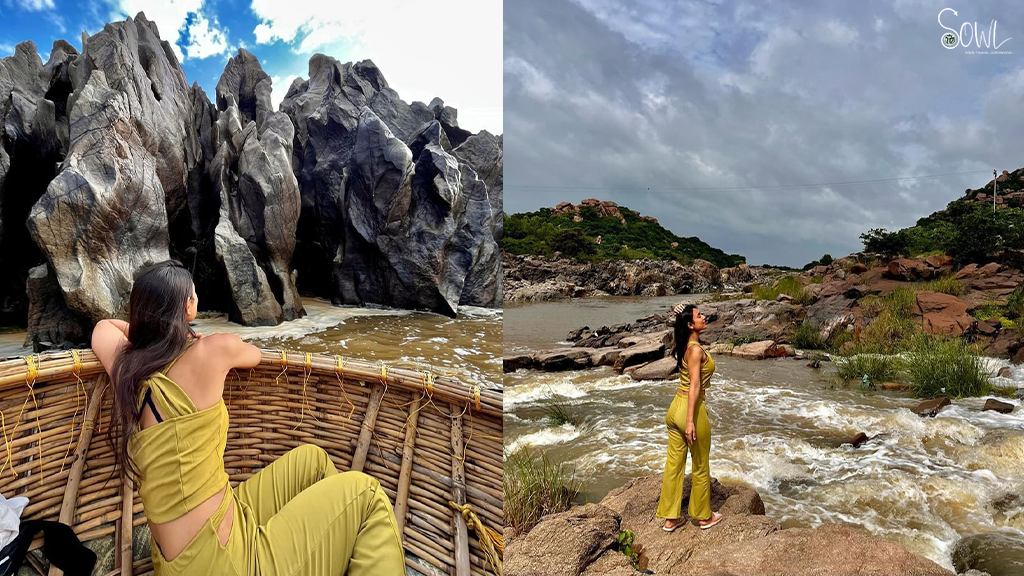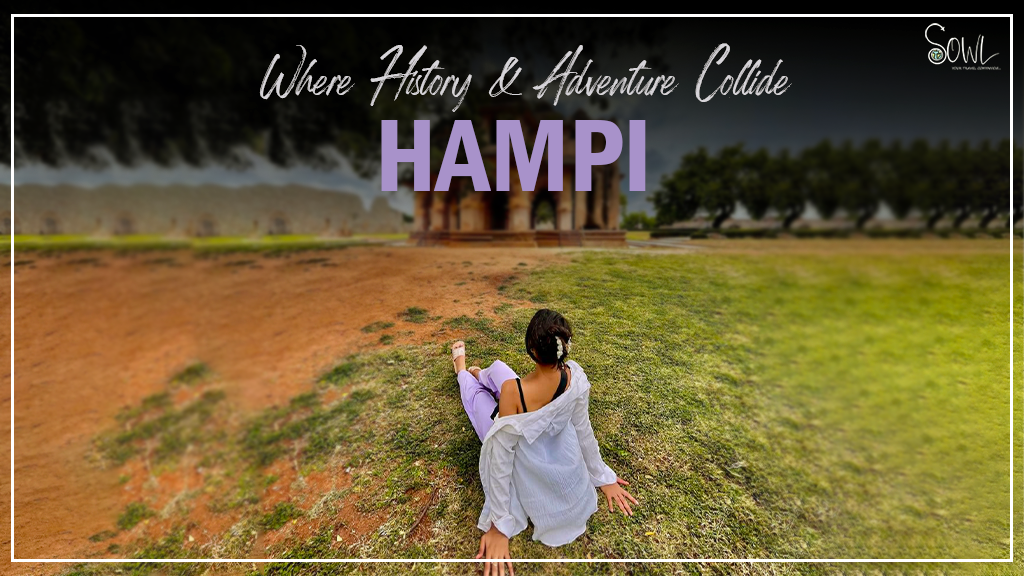Hello, historical trip lovers!!! Vartika this side, to make your time valuable reading, I am sharing my amazing experience of a trip to Hampi with my bestie. It is in the heart of Karnataka, a place that feels timeless. Also, its ancient ruins, grand temples, and stunning scenery recognised as a UNESCO World Heritage Site, invite travellers to explore history. Come along as I share my memorable journey.
Route to Hampi:
As I stepped off the train at Hospet station, the cool morning air hit me like a refreshing wave. It was 5 a.m., and I was eager to embark on a two-day adventure in Hampi. However, it is a UNESCO World Heritage Site known for its ancient ruins and temples.
Moreover, my friend and I had planned this trip for months, and we decided to make the most of our time there. Afterwards we took an auto from the station to Sanapur, our base for the next two nights,

Accommodation in Hampi:
We checked into Nature’s Cottage and Resort, a cosy and affordable stay located between lush greenery.
Places to visit in Hampi: 2-day itinerary
- Day 1: Visit to the western group of monuments
We set out to explore the western group of monuments located approximately 25 km away from Sanapur by road, or just 2 km. Also, we crossed the river and travelled by ferry. Moreover we began the day with a satisfying breakfast at the resort and rented a scooter for two days for just Rs. 300.
- Queen’s Bath:
Our first stop was Queen’s Bath, a stunning water tank with intricate carvings and a serene atmosphere.
- Royal Enclosure:
Next, we visited the Royal Enclosure, which was once the royal palace of the Vijaynagar Empire.

- Hazara Rama Temple:
The temples were equally impressive with their intricate architecture and intricate carvings. Afterwards we had lunch at the Hampi Bazaar, just outside the Virupaksha Temple. Also, the local food was not only delicious but also light on the pocket.
- Lotus Mahal:
The Lotus Mahal, situated within the enclosure, is a two-story pavilion at the heart of the royal centre. It features a blend of a symmetrical, square Hindu mandala design with lobed arches, vaults, and domes in the Indo-Islamic style.
- Visiting Temples:
After exploring various temples and ruins like Narshimha Temple, Underground Shiva Temple, Kadalekalu Ganesha Temple, and Vithala Temple Complex, we planned to return to Sanapur. In between, we took a break for chai and snacks, reached our accommodation around 8 p.m., and had dinner.
- Day 2: Visit to the Eastern Group of Monuments
On our second day, we went out to see Sanapur and Anegundi’s eastern places.
- Sanapur Waterfall:
We started our day early and visited Sanapur Waterfall, which was just a 5-minute walk from our accommodation. Also, we were alone, and the calm atmosphere was a refreshing break from the busy day before.

- Anjanadri Hills:
Our next stop was Anjanadri Hills, the birthplace of Lord Hanuman. We reached there early in the morning to witness a stunning sunrise. The view was breathtaking and left us speechless. Also explored were the rice paddy fields and the Sugriva and Vali caves.
- Pampa Sarovar:
Pampa Sarovar is a sacred lake near Hampi in Karnataka’s Koppal district. South of the Tungabhadra River, Hindus hold it in high reverence, considering it one of India’s five sacred lakes.
- Shabari Caves:
Shabari’s Cave, located near Pampa Sarovar in Hampi, is where Shabari resided and practised her austerities.
- Gagan Mahals and Anegundi Fort:
Our final stop was Gagan Mahals and Anegundi Fort. We hiked to Bala Hanuman Temple to witness a perfect sunset view. We also took a coracle ride to explore the Tungabhadra River.

Hidden Gem in Hampi
The iconic Stone Chariot is a famous monument located in front of Vijaya Vittala. It’s a shrine dedicated to Garuda, the vehicle of Lord Vishnu, and is one of India’s three most renowned stone chariots. It was designed in the Dravidian style and also it features carvings of mythical battle scenes. Constructed in the 16th century by King Krishnadevaraya of the Vijayanagara Empire. Ultimately, it is open from 8:30 a.m. to 5 p.m. daily.
Best time to visit Hampi
The ideal time to visit Hampi is during the winter season, from October to February. Also, the weather is generally pleasant, making it perfect for exploring the World Heritage Site. Above all, one of the major festivals, Vijaya Utsav (Hampi Festival), takes place in November, adding to the experience I learned from locals.
Essential things to carry in Hampi
- We also carried an extra bottle of petrol, as there are very few petrol pumps in Hampi.
- Casual shoes or sports shoes for travelling.
- Carry sunscreen and sunglasses.
- Take a backpack with food and a water bottle.
- Also, please carry medicines if you need any.
Travel tips:
- During our trip, we made sure to negotiate the rental of the scooter and talked to a few people before doing the coracle ride.
- Also, we reached our accommodation before it got dark to ensure our safety.
Our trip for two costs around Rs. 5,000–6,000, covering train tickets, accommodation, food, and transportation. The two-day Hampi adventure was truly enchanting. The ancient sites captivated us, and the serene atmosphere provided a refreshing escape from city life.For more captivating travel tales visit https://sowl.in/stories till then Happy Travel!!! Safe Travel!!!


















